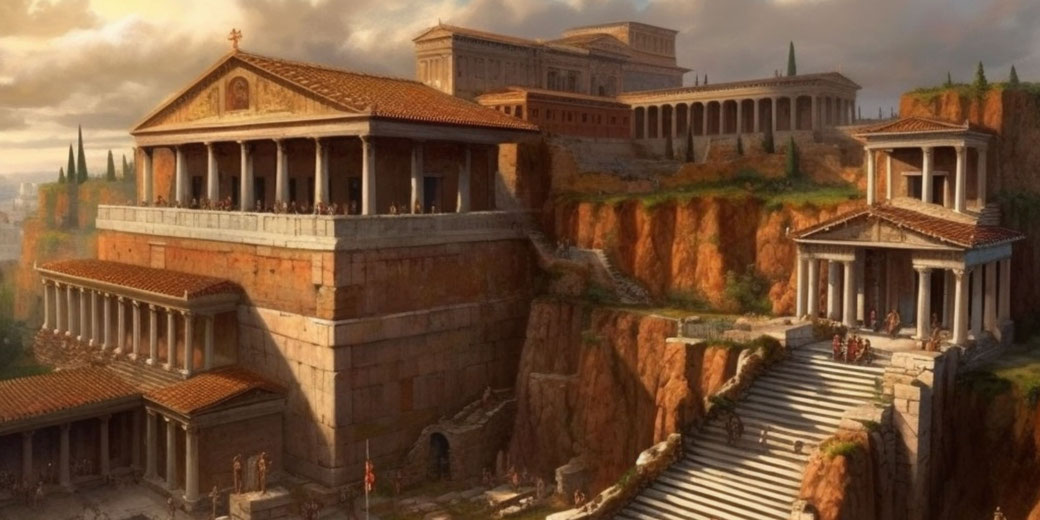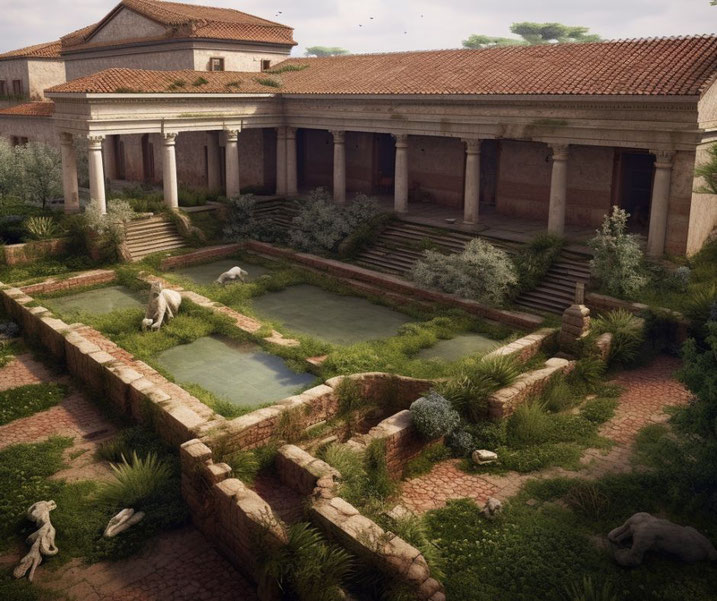Villas, insulae, domus, and slums: Why housing differed dramatically for the ancient Romans

Imagine walking through the bustling streets of ancient Rome, passing magnificent marble buildings, lavish villas, and multi-storied apartment complexes.
Welcome to the world of ancient Roman housing, a fascinating blend of architectural innovation, social stratification, and cultural expression.
Ancient Roman houses were not merely physical structures; they were manifestations of social status, economic wealth, and political power.
They provided glimpses into the day-to-day lives of their inhabitants, from the patrician elite to the plebeian masses.
Each room, each painting, each piece of decor tells a story, contributing to our understanding of Roman culture, society, and lifestyle.
What kinds of houses were in Rome?
In ancient Rome, one's abode was a distinct manifestation of their social standing.
The stratification of Roman society was clearly visible in the types of houses that different classes inhabited.
This section delves into the various types of residences that defined ancient Roman architecture.
Villas: Suburban and Rural Luxury
In the realm of the elite, the Roman villa reigned supreme. These were large, luxurious houses situated in the countryside, away from the hubbub of urban life.
They were primarily used as summer retreats for wealthy Romans wanting to escape the city's heat.
These villas often featured lavish decor, sprawling gardens, and even private bathhouses.
They weren't just homes; they were status symbols, embodying the wealth and prestige of their owners.
They also played an essential role in the agricultural economy of Rome, with many villas operating as farms or vineyards.
Domus: Urban Elite Dwellings
For those wealthy Romans who resided within the city, the domus was the dwelling of choice.
These houses, usually single-storied, were centered around a courtyard, known as the atrium.
The domus often had multiple rooms including living quarters, dining areas, and servant rooms.
The elaborate interior decor, characterized by intricate mosaics and wall frescoes, reflected the tastes and affluence of the owner.
These houses were usually located in the heart of the city, close to the Forum, symbolizing the owner's social and political connections.
Insulae: Multi-story Buildings for the Commoners
The vast majority of Rome's population, however, lived in insulae, multi-story apartment buildings that housed the city's lower classes.
These structures were often poorly constructed, cramped, and lacked basic amenities like running water.
A typical insula was made of cheap materials like wood and brick, with the lower floors often used for shops or businesses.
Despite their less desirable conditions, insulae are a testament to the urbanization and population density of ancient Rome.

Military Housing: Forts and Barracks
Lastly, there was specialized housing for Rome's mighty military. Soldiers usually lived in forts or barracks, known as castra.
These structures were practical and purpose-built, emphasizing the discipline and organization that was the hallmark of the Roman military.
Each castra was essentially a self-contained community, equipped with sleeping quarters, mess halls, and training grounds.
How Roman houses copied other cultures
The architectural styles and influences that shaped ancient Roman houses offer insights into the broader historical and cultural contexts of the time.
Rome, being a vibrant cosmopolitan empire, absorbed influences from various cultures and civilizations, which manifested itself in its domestic architecture.
Etruscan Influence on Early Roman Housing
Early Roman domestic architecture drew heavily from the Etruscans, the civilization that had dominated central Italy before Rome's ascendance.
The atrium house, characterized by a central courtyard and peripheral rooms, was a key architectural feature borrowed from the Etruscans.
This type of design facilitated natural lighting and ventilation while creating a private and comfortable living environment.
Greek Influence on Roman Domestic Architecture
As Rome expanded its influence across the Mediterranean, it came into contact with the Hellenistic world.
The Greek influence on Roman architecture is especially evident in the grandeur and opulence of Roman villas.
Many villas adopted the peristyle house plan, characterized by a columned porch or open colonnade surrounding a central courtyard, a design element borrowed from Greek architecture.
Further, the use of ornate mosaics, elaborate frescoes, and sculptures in domestic settings also reflected Greek aesthetic principles.
Innovation in Roman Architectural Techniques
While the Romans absorbed foreign influences, they were also innovators in their own right.
One significant innovation was the widespread use of concrete, which revolutionized construction techniques and allowed for the creation of architectural features such as arches, vaults, and domes.
This material was more durable and cost-effective than traditional stone, and it enabled the construction of larger and more complex structures.
The Romans also innovated in the design of multi-story apartment buildings, or insulae.
Despite often being cramped and poorly built, these buildings are a testament to Rome's urbanization and the architectural ingenuity needed to accommodate a rapidly growing urban population.
Finally, Roman military architecture, evident in forts and barracks, exhibited the practical and strategic thinking of the Romans.
The rigidly organized and fortified structures reflect the discipline and logistical prowess of the Roman military.
The blending of foreign influences with local innovations resulted in a unique architectural style that characterized ancient Roman houses.
This style was not merely aesthetic but also deeply symbolic, reflecting the broader socio-cultural realities of ancient Roman society.

Not all houses were of the same quality...
The materials and construction techniques used in ancient Roman houses are a testament to Rome's architectural ingenuity and technological prowess.
From the advent of concrete to the skillful application of decorative arts, these techniques enabled the creation of homes that were both functional and beautiful.
Early Roman houses were primarily made of wood and mud bricks. However, as Rome grew and developed, so too did its architectural techniques.
The Romans began to use more durable materials like stone and fired brick, especially in the construction of public buildings and villas.
However, the most revolutionary material in Roman architecture was concrete, known as opus caementicium.
This was a mixture of lime mortar, water, and an aggregate such as broken stone or bricks, and later, volcanic sand.
Concrete allowed for greater flexibility in design and the construction of larger, more complex structures, such as the multi-story insulae.
It was also more resistant to fire and weathering than traditional building materials.
How interiors were decorated
The Romans displayed their artistic prowess in the richly decorated interiors of their houses.
Wall paintings and mosaics were common features in Roman homes, especially in wealthier houses and villas.
Wall paintings were usually done in fresco, a technique in which pigments are applied to wet plaster, allowing the colors to become embedded in the wall surface.
Roman wall paintings often depicted landscapes, mythological scenes, and everyday life, adding color and elegance to the interior spaces.
Mosaics, made of small pieces of colored stone or glass known as tesserae, were used to create intricate designs and scenes on floors and walls.
Mosaics were labor-intensive and expensive, thus they were a way to show off wealth and status.
Marble was another material that was widely used in Roman houses, especially in wealthier homes.
Marble was used for floor slabs, wall revetment, and columns, as well as for sculptural decoration.
Different colors and types of marble were imported from various parts of the empire, reflecting Rome's extensive trade networks and the wealth of its elite.
Architectural Innovations: Vaults, Arches, and Domes
The Romans were master builders, developing techniques such as the arch, the vault, and the dome, which allowed for the construction of larger and more elaborate structures.
These elements were used in various types of buildings, including homes. For instance, wealthy houses might feature vaulted ceilings, while insulae utilized arches in their construction to support the weight of upper floors.
How houses reinforced social hierarchies
The houses of ancient Rome were not merely physical structures; they were a reflection of the cultural, social, and political fabric of the Roman society.
Every element of Roman domestic architecture, from the grand atrium to the humble insulae, provides insight into the way Romans lived and how they viewed the world.
Firstly, the diversity of Roman houses was a clear reflection of the social stratification in Roman society.
A citizen's residence was a significant marker of their social status and wealth. The grand villas of the aristocracy, with their sprawling gardens, private baths, and opulent decorations, were a testament to their owners' affluence and prestige.
On the other end of the spectrum, the crowded and poorly built insulae mirrored the living conditions of the lower classes.
Public verses private spaces
The design of Roman houses also reflected the Roman concept of public and private spaces.
The atrium, which served as a reception area for guests, was often richly decorated to impress visitors and display the family's wealth and status.
The cubicula and other private rooms, on the other hand, were typically smaller and more modestly decorated.
The Roman house was also a place of religious significance. Romans believed in household gods, or Lares, who protected the home and family.
These deities were often honored with a lararium, a small shrine typically located in the atrium.
This practice reveals the deeply ingrained religious beliefs of the Romans and the centrality of the family unit in their society.
Finally, the construction and design of Roman houses showcase their practicality. The Romans made excellent use of available resources and adapted their architecture to suit different needs and environments.
This is evident in the use of the atrium for collecting rainwater, the use of concrete in construction, and the design of multi-story insulae to accommodate the dense urban population.
How Roman houses changed over time
During the Kingdom and early Republic periods (8th-5th century BCE), Romans lived in simple huts made of mud and straw.
As the city expanded, and as Romans came into contact with other cultures like the Etruscans, they adopted more complex and durable building practices.
This period saw the development of the atrium house, a design that centered around a large, open atrium and included surrounding rooms for various purposes.
As Rome's power and wealth grew during the late Republic and early Empire (3rd century BCE-1st century CE), there was a noticeable shift towards luxury and extravagance in housing, particularly among the elite.
Influenced by the Hellenistic cultures of the Mediterranean, the Roman aristocracy began to build lavish suburban and rural villines (villas).
These homes featured multiple rooms for specific activities, complex floor plans, inner courtyards or peristyles, private baths, and ornate decorations.
Parallel to this trend was the advent of urbanization during the late Republic and Empire periods (2nd century BCE-3rd century CE).
As Rome's population burgeoned, multi-story apartment buildings, known as insulae, became the most common form of housing for the urban poor.
Despite being often poorly built and cramped, insulae marked an important step in dealing with the challenges of urban housing.
The late Roman Empire (3rd-5th century CE) saw a return to simplicity in housing, particularly in urban areas.
The domus, once the urban elite's preferred dwelling, gave way to more compact, townhouse-like structures.
These houses, while smaller and less extravagant than the domus or villa, often featured comfortable living spaces, private courtyards, and were closely integrated with the street and the broader urban fabric.
Throughout these different periods, Roman houses evolved in response to a variety of socio-economic and cultural influences.
They transformed from simple huts to grand villas, and from individual domus to multi-story insulae.
This evolution reflects not just changing architectural styles and construction techniques, but also broader trends in Roman society, from urbanization and cultural exchange to shifts in social norms and lifestyle patterns.
Through their houses, we can trace the Romans' journey from a small city-state to a cosmopolitan empire.

What do you need help with?
Download ready-to-use digital learning resources
Copyright © History Skills 2014-2025.
Contact via email
With the exception of links to external sites, some historical sources and extracts from specific publications, all content on this website is copyrighted by History Skills. This content may not be copied, republished or redistributed without written permission from the website creator. Please use the Contact page to obtain relevant permission.





